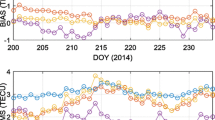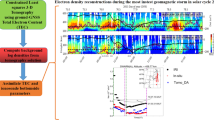Abstract
A self-contained global ionospheric maps (GIM)-aided Abel retrieval method is adopted that can account for spherical non-uniformity along the radio wave path in the vicinity of the radio occultation (RO) region using the asymmetry factors derived from global background N m F 2 maps. This procedure does not require any supplementary data sources to augment the Abel retrieval in order to represent the horizontal gradients in the ionosphere. This simulation study demonstrates that when sufficiently dense RO observations are available, the N m F 2 values initially derived from classical Abel retrieval (with the assumption of spherical symmetry) are sufficiently good and useful to represent the spherical non-uniformities in electron density distribution. The Ne(h) profiles retrieved from this Abel retrieval procedure aided with asymmetry factors provide significant improvement compared to classical Abel retrieval at both F- and E-regions. The artificial large-scale structures, such as wave number-3 latitudinal structure and plasma caves underneath the equatorial ionization anomaly crests, were largely eliminated. This improved retrieval procedure also reduces the computational complexity and is suitable when the number of occultations increased by many times in the future when FORMOSAT-7/COSMIC-2 (F7/C2) and other RO missions become operational. The computation simplicity in this self-contained GIM-aided Abel retrieval procedure enables more accurate retrieval of Ne(h) profiles in near real time.







Similar content being viewed by others
References
Anthes RA et al (2008) The COSMIC/FORMOSAT-3 mission: early results. Bull Am Meteorol Soc 89:313–333. doi:10.1175/BAMS-89-3-313
Aragon-Angel A, Liou YA, Lee CC, Reinisch BW, Hernandez-Pajares M, Juan M, Sanz J (2011) Improvement of retrieved FORMOSAT-3/COSMIC electron densities validated by ionospheric sounder measurements at Jicamarca. Radio Sci 46:RS5002. doi:10.1029/2010RS004578
de La Beaujardière O et al (2004) C/NOFS: a mission to forecast scintillations. J Atmos Sol Terr Phys 66:1573. doi:10.1016/j.jastp.2004.07.030
Garcia-Fernandez M, Hernandez-Pajares M, Juan M, Sanz J (2003) Improvement of ionospheric electron density estimation with GPSMET occultations using Abel inversion and VTEC information. J Geophys Res 108(A9):1338. doi:10.1029/2003JA009952
Hajj GA, Romans LJ (1998) Ionospheric electron density profiles obtained with the Global Positioning System: results from the GPS/MET experiment. Radio Sci 33:175–190
Hajj G, Lee L, Pi X, Romans L, Schreiner W, Straus P, Wang C (2000) COSMIC GPS ionospheric sensing and space weather. Terr Atmos Ocean Sci 11(1):235–272
Hajj GA, Ao CO, Iijima BA, Kuang D, Kursinski ER, Mannucci AJ, Meehan TK, Romans LJ, de la Torre Juarez M, Yunck TP (2004) CHAMP and SAC-C atmospheric occultation results and intercomparisons. J Geophys Res 109:D06109. doi:10.1029/2003JD003909
Hernandez-Pajares M, Juan M, Sanz J (2000) Improving the Abel inversion by adding ground GPS data to LEO radio occultations in ionospheric sounding. Geophys Res Lett 27:2473–2476
Jeffrey A (1985) mathematics for engineers and scientists, 3rd edn. ELBS/Van Nostrand Reanhold, London, pp 304–322
Kulikov I, Munnicci AJ, Pi X, Raymond C, Hajj GA (2011) Electron density retrieval from occulting GNSS signals using a gradient aided inversion technique. Adv Space Res 47(2):289–295
Larsen GB, Syndergaard S, Hoeg P, Soresen MB (2005) Single frequency processing of Ørsted GPS radio occultation measurements. GPS Solut 9:144–155. doi:10.1007/s10291-005-0142-x
Lee IT, Tsai HF, Liu JY, Lin CH, Matsuo T, Chang LC (2013) Modelling impact of FORMOSAT-7/COSMIC-2 mission on ionospheric space weather monitoring. J Geophys Res Space Phys 118:6518–6523. doi:10.1002/jgra.50538
Lei J et al (2007) Comparison of COSMIC ionospheric measurements with ground-based observations and model predictions: preliminary results. J Geophys Res 112:A07308. doi:10.1029/2006JA012240
Leitinger R, Radicella S, Nava B (2002) Electron density models for assessment studies—new developments. Acta Geodet Geophys Hung 37:183–193
Liang MC, Li KF, Shia RL, Yung YL (2008) Short-period solar cycle signals in the ionosphere observed by FORMOSAT-3/COSMIC. Geophys Res Lett 35:L15818. doi:10.1029/2008GL034433
Lin CH, Liu JY, Fang TW, Chang PY, Tsai HF, Chen CH, Hsaio CC (2007) Motions of the equatorial ionization anomaly crests imaged by FORMOSAT-3/COSMIC. Geophys Res Lett 34:L19101. doi:10.1029/2007GL030741
Lin CH, Liu JY, Cheng CZ, Chen CH, Liu CH, Wang W, Burns AG, Lei J (2009) Three-dimensional ionosphere electron density structure of the Weddell Sea Anomaly. J Geophys Res 114:A02312. doi:10.1029/2008JA013455
Liu JY, Lee CC, Yang JY, Chen CY, Reinisch BW (2010) Electron density profiles in the equatorial ionosphere observed by the FORMOSAT-3/COSMIC and a Digisonde at Jicamarca. GPS Solut 14:75–81. doi:10.1007/s10291-009-0150-3
Olsen N et al (2013) The swarm satellite constellation application and research facility (SCARF) and SWARM data products. Earth Planet Space 65:1189–1200
Riley KF, Hobson MP, Bense SJ (2002) Mathematical methods for physics and engineering, 2nd edn. Cambridge University Press, Cambridge, pp 57–58
Schreiner WS, Sokolovsky SV, Rocken C, Hunt DC (1999) Analysis and validation of GPS/MET radio occultation data in the ionosphere. Radio Sci 34:949–966
Tsai LC, Tsai WH (2004) Improvement of GPS/MET ionospheric profiling and validation using Chung-Li ionosonde measurements and the IRI model. Terr Atmos Oceanic Sci 15:589–607
Tsai LC, Cheng KC, Liu CH (2011) GPS radio occultation measurements on ionospheric electron density from low Earth orbit. J Geod 85:941–948. doi:10.1007/s00190-011-0476-9
Tulasi Ram S, Su SY, Liu CH (2009) FORMOSAT-3/COSMIC observations of seasonal and longitudinal variations of equatorial ionization anomaly and its interhemispheric asymmetry during the solar minimum period. J Geophys Res 114:A06311. doi:10.1029/2008JA013880
Tulasi Ram S, Lei J, Su SY, Liu CH, Lin CH, Chen WS (2010a) Dayside ionospheric response to recurrent geomagnetic activity during the extreme solar minimum of 2008. Geophys Res Lett 37:L02101. doi:10.1029/2009GL041038
Tulasi Ram S, Liu CH, Su SY (2010b) Periodic solar wind forcing due to recurrent coronal holes during 1996–2009 and its impact on Earth’s geomagnetic and ionospheric properties during the extreme solar minimum. J Geophys Res 115:A12340. doi:10.1029/2010JA015800
Tulasi Ram S, Liu CH, Su SY, Heelis RA (2010c) comparison of ionospheric O+/light-ion transition height derived from ion-composition measurements and the topside ion density profiles over equatorial latitudes. Geophys Res Lett 37:L20107. doi:10.1029/2010GL045199
Ware R et al (1996) GPS sounding of the atmosphere from low Earth orbit: preliminary results. Bull Am Meterol Soc 77:19–40
Wickert J, Gobiet A, Beyerle G, Steiner AK, Kirchengast G, Foelsche U, Schmidt T (2005) GPS radio occultation with CHAMP: comparison of atmospheric profiles from GFZ Potsdam and IGAM Graz. In: Earth observation with CHAMP. Springer, Berlin, pp 525–530
Wickert J, Beyerle G, Konig R, Heise S, Grunwaldt L, Michalak G, Reigber Ch, Schmidt T (2005b) GPS radio occultation with CHAMP and GRACE: a first look at a new and promising satellite configuration for global atmospheric sounding. Ann Geophys 23:653–658
Yue X, Schreiner WS, Lei J, Sokolovskiy SV, Rocken C, Hunt DC, Kuo YH (2010) Error analysis of Abel retrieved electron density profiles from radio occultation measurements. Ann Geophys 23:217–222
Yue X, Schreiner WS, Kuo YH (2012) Evaluating the effect of global ionospheric map on aiding retrieval of radio occultation electron density profiles. GPS Solut. doi:10.1007/s10291-012-0281-9
Yue X, Schreiner WS, Pedatella N, Anthes RA, Mannucci AJ, Straus PR, Liu JY (2014) Space Weather observations by GNSS Radio Occultation: from FORMOSAT-3/COSMIC to FORMOSAT-7/COSMIC-2. Space Weather. doi:10.1002/2014SW001133
Acknowledgments
This work is supported by Department of Science and Technology (DST), Govt. of India, under India–Taiwan science and technology cooperation program through Project Nos. GITA/DST/TWN/P-47/2013 and NSC 102-2923-M008-002-MY3. The orbital parameters of GPS and COSMIC satellites were provided through podTEC files by UCAR-CDAAC at http://cdaac-www.cosmic.ucar.edu/. The NeQuick model source code is provided by Ionosphere Radio Propagation Unit of the T/ICT4D Laboratory.
Author information
Authors and Affiliations
Corresponding author
Rights and permissions
About this article
Cite this article
Tulasi Ram, S., Su, SY., Tsai, LC. et al. A self-contained GIM-aided Abel retrieval method to improve GNSS-Radio Occultation retrieved electron density profiles. GPS Solut 20, 825–836 (2016). https://doi.org/10.1007/s10291-015-0491-z
Received:
Accepted:
Published:
Issue Date:
DOI: https://doi.org/10.1007/s10291-015-0491-z




